Panasonic KX-TES824, KX-TEM824 Service Manual
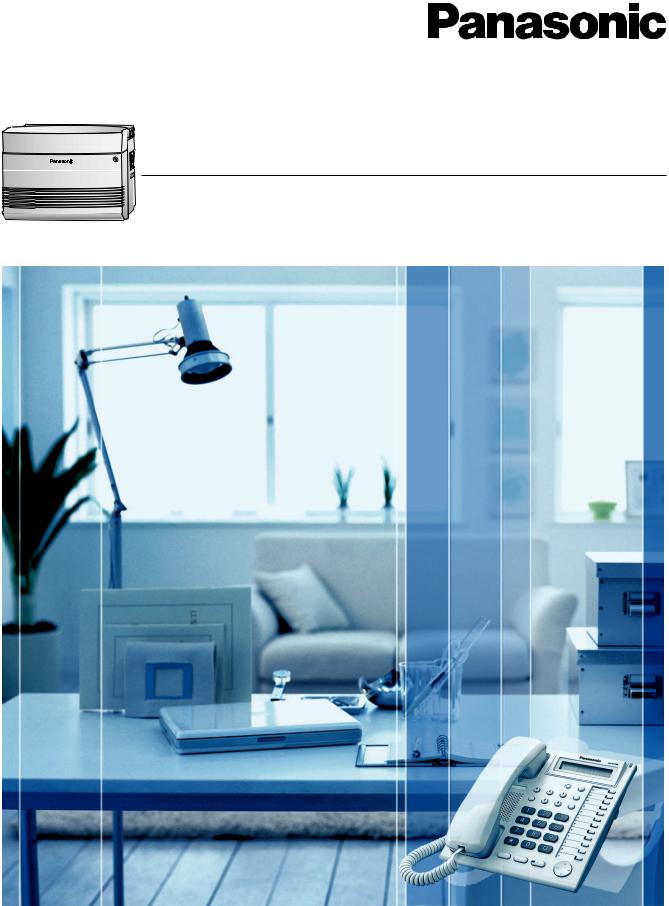
Advanced Hybrid System
Feature Guide
KX-TES824
Model KX-TEM824
Thank you for purchasing a Panasonic Advanced Hybrid System.
Please read this manual carefully before using this product and save this manual for future use.

Introduction
About this Feature Guide
The Feature Guide is designed to serve as an overall reference describing the features of the Panasonic Advanced Hybrid System.
It explains what the Advanced Hybrid System can do, as well as how to obtain the most of its many features and facilities.
The Feature Guide is divided into the following sections:
Section 1, Call Handling Features
Describes the features of the Advanced Hybrid System related to making and receiving calls, and operating telephones.
Section 2, System Configuration and Administration Features
Describes the features that allow the Advanced Hybrid System to be configured and administered to suit the needs of its users.
Section 3, Programming Instructions
Serves as an overall system programming reference for the Advanced Hybrid System.
Section 4, Appendix
Provides tables that describe the resource capacity of the Advanced Hybrid System, as well as its different tones and ring tones.
Index
References Found in the Feature Guide
Installation Manual References
The Installation Manual provides instructions detailing the installation and maintenance of the PBX. Sections from the Installation Manual are listed throughout the Feature Guide for your reference.
Feature Guide References
Related sections of the Feature Guide are listed for your reference.
User Manual References
The User Manual describes how users can access commonly used PBX features and functions with their proprietary telephones (PTs), single line telephones (SLTs), and Direct Station Selection (DSS) Consoles. Sections from the User Manual are listed throughout the Feature Guide for your reference.
PT Programming References
Commonly used settings can be programmed using a display PT ( 2.3.2 PT Programming). These PT programming items are noted throughout the Feature Guide for your reference by title and programme number. The following is an example of a PT Programming reference:
2.3.2 PT Programming). These PT programming items are noted throughout the Feature Guide for your reference by title and programme number. The following is an example of a PT Programming reference:
"Idle extensions are automatically searched for according to a preprogrammed hunting type ( Hunting Type [101])."
Hunting Type [101])."
2 Feature Guide
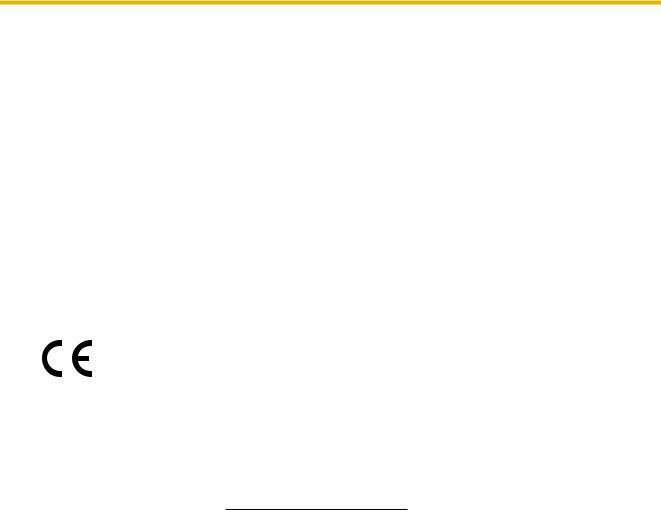
Links to Other Pages and Manuals
If you are viewing this Feature Guide with a PC, certain items are linked to different sections of the Feature Guide and other Advanced Hybrid System manuals. Click on a link to jump to that section.
Linked items include:
•Installation Manual References
•Feature Guide References
•User Manual References
•PT Programming References
Notes
•Certain PTs, features, and optional service cards are not available in some areas. Consult your certified Panasonic dealer for more information.
•Every system programming setting can be accessed using a PC and the Panasonic KX-TE Maintenance Console software ( 2.3.1 PC Programming). For programming details, refer to the online help that is installed along with KX-TE Maintenance Console (
2.3.1 PC Programming). For programming details, refer to the online help that is installed along with KX-TE Maintenance Console ( 3.2.1 Installing and Starting KXTE Maintenance Console).
3.2.1 Installing and Starting KXTE Maintenance Console).
The KX-TES824E, the KX-TES824NE, the KX-TES824GR/KX-TEM824GR, the KX-TES824CE/KX-TEM824CE, and the KX-TES824PD/KX-TEM824PD are designed to interwork with the Analogue Public Switched Telephone Network (PSTN) of European countries.
Panasonic Communications Co., Ltd./Panasonic Communications Company (U.K.) Ltd. declares that this equipment is in compliance with the essential requirements and other relevant provisions of Radio & Telecommunications Terminal Equipment (R&TTE) Directive 1999/5/EC.
Declarations of Conformity for the relevant Panasonic products described in this manual are available for download by visiting:
http://doc.panasonic.de
Contact:
Panasonic Services Europe GmbH
Panasonic Testing Centre
Winsbergring 15, 22525 Hamburg, F.R. Germany
Trademarks
•Microsoft and Windows are either registered trademarks or trademarks of Microsoft Corporation in the United States and/or other countries.
•Intel and Pentium are trademarks or registered trademarks of Intel Corporation or its subsidiaries in the United States and other countries.
•All other trademarks identified herein are the property of their respective owners.
Feature Guide |
3 |
|
|

List of Abbreviations
A |
AA |
Automated Attendant |
|
APT |
Analogue Proprietary Telephone |
|
ARS |
Automatic Route Selection |
B |
BGM |
Background Music |
|
BSS |
Busy Station Signalling |
|
BV |
Built-in Voice Message |
C |
COS |
Class of Service |
|
CPC |
Calling Party Control |
D |
DIL |
Direct In Line |
|
DISA |
Direct Inward System Access |
|
DND |
Do Not Disturb |
|
DRD |
Distinctive Ring Detection |
|
DSS |
Direct Station Selection |
|
DTMF |
Dual Tone Multi-Frequency |
E |
EFA |
External Feature Access |
F |
FWD |
Call Forwarding |
G |
G-CO |
Group-CO |
I |
IRNA |
Intercept Routing—No Answer |
L |
LCS |
Live Call Screening |
|
LED |
Light Emitting Diode |
O |
O-CO |
Other-CO |
|
OGM |
Outgoing Message |
P |
PF |
Programmable Feature |
|
PSTN |
Public Switched Telephone Network |
|
PT |
Proprietary Telephone |
S |
S-CO |
Single-CO |
|
SLT |
Single Line Telephone |
|
SMDR |
Station Message Detail Recording |
|
SMS |
Short Message Service |
T |
TRS |
Toll Restriction |
|
TAM |
Telephone Answering Machine |
U |
UCD |
Uniform Call Distribution |
V |
VM |
Voice Mail |
|
VPS |
Voice Processing System |
4 Feature Guide

Feature Highlights
Built-in Voice Message (BV)
Built-in Voice Message (BV) allows a caller to leave a voice message in a user's personal message area or the PBX's common message area, if an optional voice message card is installed in the PBX ( 1.15.7 Builtin Voice Message (BV)).
1.15.7 Builtin Voice Message (BV)).
Call Routing for Fixed Line SMS
The PBX can relay incoming calls from a Short Message Service (SMS) centre to specific single line telephones (SLTs) that support SMS. Fixed Line SMS is a service that allows text messages to be sent and received via Public Switched Telephone Network (PSTN) access ( 1.17.3 Call Routing for Fixed Line SMS).
1.17.3 Call Routing for Fixed Line SMS).
Caller ID Display on SLT
The PBX can receive Caller ID information (telephone numbers and callers' names) from calls received on outside (CO) lines. This information can be shown on the displays of some SLTs as well as proprietary telephones (PTs) when receiving calls ( 1.16.1 Caller ID).
1.16.1 Caller ID).
3-level Automated Attendant (AA)
3-level Automated Attendant (AA) service allows a caller to dial a single-digit number (Direct Inward System Access [DISA] AA number) following the guidance of 3-level DISA outgoing messages (OGMs), and be connected to the desired party automatically ( 1.15.6 Direct Inward System Access (DISA)).
1.15.6 Direct Inward System Access (DISA)).
PC Programming
System programming settings can be accessed using a PC and the Panasonic KX-TE Maintenance Console software as well as by using a PT ( 2.3.1 PC Programming).
2.3.1 PC Programming).
The PBX software can be upgraded via the Serial Interface (RS-232C port) or USB port, using the KX-TE Maintenance Console software ( 2.3.7 Firmware Upgrade).
2.3.7 Firmware Upgrade).
Automatic Configuration for Outside (CO) Line Type
The dialling mode of connected outside (CO) lines is automatically configured the first time the PBX is accessed with a PC using the KX-TE Maintenance Console software, or after the PBX data has been cleared ( 2.3.5 Automatic Configuration for Outside (CO) Line Type).
2.3.5 Automatic Configuration for Outside (CO) Line Type).
Advanced Hybrid System
This PBX supports the connection of PTs*1, Direct Station Selection (DSS) Consoles, and single line devices such as SLTs, fax machines, wireless telephones, and data terminals.
*1 In this manual, "proprietary telephone" ("PT") means an analogue proprietary telephone (APT).
Feature Guide |
5 |
|
|

Table of Contents |
|
|
1 Call Handling Features......................................................................... |
13 |
|
1.1 |
Incoming Call Features.................................................................................................. |
14 |
1.1.1 Incoming Outside (CO) Line Call Features ...................................................................... |
14 |
|
1.1.1.1 |
Direct In Line (DIL) .......................................................................................................................................... |
14 |
1.1.1.2 |
Intercept Routing ............................................................................................................................................. |
15 |
1.1.2 |
Internal Call Features....................................................................................................... |
16 |
1.1.3 Incoming Call Indication Features.................................................................................... |
17 |
|
1.1.3.1 Incoming Call Indication Features—OVERVIEW............................................................................................. |
17 |
|
1.1.3.2 |
Outside (CO) Line Ringing Selection............................................................................................................... |
18 |
1.1.3.3 |
Ring Tone Pattern Selection ............................................................................................................................ |
19 |
1.1.3.4 Distinctive Ring Detection (DRD) for New Zealand ......................................................................................... |
20 |
|
1.1.3.5 |
Call Waiting ..................................................................................................................................................... |
22 |
1.2 |
Receiving Group Features ............................................................................................ |
23 |
1.2.1 |
Idle Extension Hunting ..................................................................................................... |
23 |
1.2.2 Uniform Call Distribution (UCD) ....................................................................................... |
25 |
|
1.2.3 Direct Inward System Access (DISA) Ring ...................................................................... |
28 |
|
1.2.4 Log-in/Log-out .................................................................................................................. |
29 |
|
1.3 |
Call Forwarding (FWD)/Do Not Disturb (DND) Features ............................................. |
30 |
1.3.1 Call Forwarding (FWD)/Do Not Disturb (DND)................................................................. |
30 |
|
1.3.1.1 Call Forwarding (FWD)/Do Not Disturb (DND)—OVERVIEW.......................................................................... |
30 |
|
1.3.1.2 |
Call Forwarding (FWD) .................................................................................................................................... |
31 |
1.3.1.3 Do Not Disturb (DND)...................................................................................................................................... |
34 |
|
1.4 |
Answering Features....................................................................................................... |
35 |
1.4.1 |
Answering Features ......................................................................................................... |
35 |
1.4.1.1 |
Answering Features—OVERVIEW .................................................................................................................. |
35 |
1.4.1.2 |
Line Preference—Incoming ............................................................................................................................. |
36 |
1.4.1.3 |
Call Pickup....................................................................................................................................................... |
37 |
1.4.1.4 |
Hands-free Answerback .................................................................................................................................. |
38 |
1.5 |
Making Call Features ..................................................................................................... |
39 |
1.5.1 |
Intercom Call Features ..................................................................................................... |
39 |
1.5.1.1 |
Intercom Call ................................................................................................................................................... |
39 |
1.5.2 Outside (CO) Line Call Features ...................................................................................... |
41 |
|
1.5.2.1 Outside (CO) Line Call Features—OVERVIEW............................................................................................... |
41 |
|
1.5.2.2 |
Emergency Call ............................................................................................................................................... |
42 |
1.5.2.3 |
Account Code Entry ........................................................................................................................................ |
43 |
1.5.2.4 |
Dial Type Selection .......................................................................................................................................... |
44 |
1.5.2.5 |
Reverse Circuit ................................................................................................................................................ |
45 |
1.5.2.6 |
Pause Insertion................................................................................................................................................ |
46 |
1.5.2.7 Host PBX Access Code (Access Code to the Telephone Company from a Host PBX) .................................. |
47 |
|
1.5.3 Seizing a Line Features ................................................................................................... |
49 |
|
1.5.3.1 Seizing a Line Features—OVERVIEW ............................................................................................................ |
49 |
|
1.5.3.2 |
Line Preference—Outgoing ............................................................................................................................. |
50 |
1.5.3.3 Outside (CO) Line Access ............................................................................................................................... |
51 |
|
1.6 |
Memory Dialling Features ............................................................................................. |
53 |
1.6.1 |
Memory Dialling Features ................................................................................................ |
53 |
1.6.1.1 |
Memory Dialling Features—OVERVIEW ......................................................................................................... |
53 |
1.6.1.2 |
One-touch Dialling ........................................................................................................................................... |
55 |
1.6.1.3 |
KX-T7710 One-touch Dialling.......................................................................................................................... |
56 |
1.6.1.4 |
Redial ............................................................................................................................................................. |
57 |
1.6.1.5 |
Speed Dialling—Personal/System................................................................................................................... |
58 |
1.6.1.6 |
Quick Dialling................................................................................................................................................... |
59 |
1.6.1.7 |
Hot Line ........................................................................................................................................................... |
60 |
6 Feature Guide

1.7 |
Busy Line/Busy Party Features.................................................................................... |
61 |
1.7.1 |
Automatic Callback Busy (Camp-on)............................................................................... |
61 |
1.7.2 |
Executive Busy Override ................................................................................................. |
62 |
1.7.3 |
Call Waiting Tone............................................................................................................. |
63 |
1.8 |
Toll Restriction (TRS) Features .................................................................................... |
64 |
1.8.1 |
Toll Restriction (TRS)....................................................................................................... |
64 |
1.8.2 |
Toll Restriction (TRS) Override by Account Code ........................................................... |
68 |
1.8.3 |
Extension Lock ................................................................................................................ |
70 |
1.8.4 |
Walking COS ................................................................................................................... |
71 |
1.9 |
Automatic Route Selection (ARS) Features................................................................ |
72 |
1.9.1 |
Automatic Route Selection (ARS) ................................................................................... |
72 |
1.10 |
Conversation Features.................................................................................................. |
78 |
1.10.1 |
Hands-free Operation ...................................................................................................... |
78 |
1.10.2 |
Room Monitor .................................................................................................................. |
79 |
1.10.3 |
Microphone Mute............................................................................................................. |
80 |
1.10.4 |
Headset Operation .......................................................................................................... |
81 |
1.10.5 |
Data Line Security ........................................................................................................... |
82 |
1.10.6 |
Flash/Recall..................................................................................................................... |
83 |
1.10.7 |
External Feature Access (EFA) ....................................................................................... |
84 |
1.10.8 |
Outside (CO) Line Call Limitation .................................................................................... |
85 |
1.10.9 |
Parallelled Telephone ...................................................................................................... |
86 |
1.10.10 |
Calling Party Control (CPC) Signal Detection ................................................................. |
87 |
1.11 |
Transferring Features.................................................................................................... |
88 |
1.11.1 |
Call Transfer..................................................................................................................... |
88 |
1.12 |
Holding Features ........................................................................................................... |
90 |
1.12.1 |
Call Hold .......................................................................................................................... |
90 |
1.12.2 |
Call Park .......................................................................................................................... |
92 |
1.12.3 |
Call Splitting..................................................................................................................... |
93 |
1.12.4 |
Music on Hold.................................................................................................................. |
94 |
1.12.5 |
Consultation Hold ............................................................................................................ |
95 |
1.13 |
Conference Features..................................................................................................... |
96 |
1.13.1 |
Conference Features ....................................................................................................... |
96 |
1.13.1.1 |
Conference Features—OVERVIEW................................................................................................................. |
96 |
1.13.1.2 |
Conference ...................................................................................................................................................... |
97 |
1.14 |
Paging Features............................................................................................................. |
99 |
1.14.1 |
Paging ............................................................................................................................. |
99 |
1.15 |
Optional Device Features ........................................................................................... |
100 |
1.15.1 |
Doorphone Call ............................................................................................................. |
100 |
1.15.2 |
Door Open ..................................................................................................................... |
101 |
1.15.3 |
Doorbell/Door Chime ..................................................................................................... |
102 |
1.15.4 |
Background Music (BGM) ............................................................................................. |
104 |
1.15.5 |
Outgoing Message (OGM) for DISA/UCD ..................................................................... |
105 |
1.15.6 |
Direct Inward System Access (DISA) ............................................................................ |
106 |
1.15.7 |
Built-in Voice Message (BV) .......................................................................................... |
113 |
1.16 |
Caller ID Features ........................................................................................................ |
118 |
1.16.1 |
Caller ID......................................................................................................................... |
118 |
1.16.2 |
Incoming Call Log.......................................................................................................... |
122 |
1.17 |
Message Features ....................................................................................................... |
125 |
1.17.1 |
Message Waiting ........................................................................................................... |
125 |
1.17.2 |
Absent Message............................................................................................................ |
127 |
1.17.3 |
Call Routing for Fixed Line SMS.................................................................................... |
128 |
Feature Guide |
7 |
|
|

1.18 |
Proprietary Telephone (PT) Features ......................................................................... |
131 |
1.18.1 |
Fixed Buttons ................................................................................................................. |
131 |
1.18.2 |
Flexible Buttons.............................................................................................................. |
133 |
1.18.3 |
LED Indication................................................................................................................ |
135 |
1.18.4 |
Display Information......................................................................................................... |
137 |
1.19 |
Voice Mail Features...................................................................................................... |
138 |
1.19.1 |
Voice Mail APT Integration ............................................................................................. |
138 |
1.19.2 |
Voice Mail Inband (DTMF) Integration............................................................................ |
144 |
1.20 |
Administrative Information Output Features............................................................. |
147 |
1.20.1 |
Station Message Detail Recording (SMDR)................................................................... |
147 |
1.20.2 |
Call Log Printout for Each Extension ............................................................................. |
152 |
1.21 |
Extension Controlling Features.................................................................................. |
153 |
1.21.1 |
Extension Feature Clear ................................................................................................ |
153 |
1.21.2 |
Timed Reminder............................................................................................................. |
154 |
1.22 |
Audible Tone Features................................................................................................. |
155 |
1.22.1 |
Dial Tone ........................................................................................................................ |
155 |
1.22.2 |
Confirmation Tone .......................................................................................................... |
156 |
2 System Configuration and Administration Features ...................... |
157 |
|
2.1 |
System Configuration—Hardware .............................................................................. |
158 |
2.1.1 |
Extension Jack Configuration......................................................................................... |
158 |
2.2 |
System Configuration—Software ............................................................................... |
159 |
2.2.1 |
Class of Service (COS) .................................................................................................. |
159 |
2.2.2 |
Group ............................................................................................................................. |
160 |
2.2.3 |
Time Service .................................................................................................................. |
162 |
2.2.4 |
Operator/Manager Features........................................................................................... |
165 |
2.3 |
System Data Control.................................................................................................... |
167 |
2.3.1 |
PC Programming............................................................................................................ |
167 |
2.3.2 |
PT Programming ............................................................................................................ |
170 |
2.3.3 |
Automatic Time Adjustment ........................................................................................... |
172 |
2.3.4 |
Feature Numbering ........................................................................................................ |
173 |
2.3.5 |
Automatic Configuration for Outside (CO) Line Type ..................................................... |
178 |
2.3.6 |
Country Setting .............................................................................................................. |
179 |
2.3.7 |
Firmware Upgrade ......................................................................................................... |
180 |
2.4 |
Fault Recovery/Diagnostics ........................................................................................ |
181 |
2.4.1 |
Power Failure Transfer.................................................................................................... |
181 |
2.4.2 |
Power Failure Restart..................................................................................................... |
182 |
3 Programming Instructions................................................................. |
183 |
|
3.1 |
Introduction .................................................................................................................. |
184 |
3.1.1 |
Introduction .................................................................................................................... |
184 |
3.2 |
PC Programming.......................................................................................................... |
185 |
3.2.1 |
Installing and Starting KX-TE Maintenance Console ..................................................... |
185 |
3.3 |
PT Programming .......................................................................................................... |
186 |
3.3.1 |
Programming Instructions .............................................................................................. |
186 |
3.3.2 |
Programming Procedures .............................................................................................. |
191 |
|
Date & Time [000].......................................................................................................................................... |
191 |
|
System Speed Dialling Number [001]............................................................................................................ |
191 |
|
System Password [002] ................................................................................................................................. |
192 |
|
DSS Console Jack Assignment [003] ............................................................................................................ |
193 |
|
Console Paired Telephone [004].................................................................................................................... |
193 |
|
One-touch Transfer Using a DSS Button [005] .............................................................................................. |
193 |
8 Feature Guide

Time Service Switching Mode [006] .............................................................................................................. |
194 |
Time Service Start Time [007] ....................................................................................................................... |
194 |
Operator Assignment [008] ............................................................................................................................ |
194 |
Extension Number [009] ................................................................................................................................ |
195 |
LCD Time Display [010] ................................................................................................................................. |
195 |
System Speed Dialling Name [011] ............................................................................................................... |
196 |
Second Feature Numbering Plan [012].......................................................................................................... |
196 |
KX-T7710 One-touch Dialling [013] ............................................................................................................... |
197 |
Hunting Group Set [100] ................................................................................................................................ |
197 |
Hunting Type [101] ......................................................................................................................................... |
197 |
DTMF Integration Port [102] .......................................................................................................................... |
198 |
DTMF Integration [103] .................................................................................................................................. |
198 |
SLT Hold Mode [104] ..................................................................................................................................... |
198 |
Conference Tone [105]................................................................................................................................... |
198 |
External Pager Access Tone [106]................................................................................................................. |
199 |
DTMF Receiver Check [107].......................................................................................................................... |
199 |
Flash/Recall Mode for a Locked Extension [108]........................................................................................... |
199 |
CO Indicator [109].......................................................................................................................................... |
199 |
Flash/Recall Key Mode [110] ......................................................................................................................... |
200 |
Music on Hold [111] ....................................................................................................................................... |
200 |
DSS Lamp Mode [112] .................................................................................................................................. |
200 |
Automatic Redial Repeat Count [113]............................................................................................................ |
200 |
Automatic Redial Interval [114] ...................................................................................................................... |
201 |
Extension Ring Tone Pattern [115] ................................................................................................................ |
201 |
Conference Pattern [116]............................................................................................................................... |
201 |
Call Pickup Tone [117] ................................................................................................................................... |
201 |
Pulse Restriction [118]................................................................................................................................... |
202 |
Redialling after Pulse to Tone Conversion [119] ............................................................................................ |
202 |
Bell Frequency [120] ...................................................................................................................................... |
202 |
Automatic Line Access [121].......................................................................................................................... |
202 |
Automatic Rotation for CO Line Access [122]................................................................................................ |
202 |
Break Ratio [123] ........................................................................................................................................... |
203 |
TRS Check for * and # [125] .......................................................................................................................... |
203 |
DSS Off-hook Mode [126].............................................................................................................................. |
203 |
Pickup Group [127] ........................................................................................................................................ |
203 |
Ringback Tone Pattern [128].......................................................................................................................... |
203 |
VM 1 APT Port [130] ...................................................................................................................................... |
204 |
VM 2 APT Port [131] ...................................................................................................................................... |
204 |
SLT Ring/Silence Ratio [142] ......................................................................................................................... |
204 |
SLT Ring Bell-on Time [143] .......................................................................................................................... |
205 |
SMS Centre Number for Receiving [145]....................................................................................................... |
205 |
SMS Routing Table—CO [146] ...................................................................................................................... |
205 |
SMS Routing Table—Extension [147]............................................................................................................ |
206 |
SLT Caller ID Signalling Type [150]................................................................................................................ |
206 |
SLT Caller ID Line Access Number [151] ...................................................................................................... |
206 |
Automatic Time Adjustment [152] .................................................................................................................. |
206 |
Incoming Reverse [153] ................................................................................................................................. |
206 |
Hold Recall Time [200] .................................................................................................................................. |
207 |
Transfer Recall Time [201] ............................................................................................................................. |
207 |
Call Forwarding Start Time [202] ................................................................................................................... |
207 |
Hot Line Waiting Time [203]........................................................................................................................... |
207 |
Call Duration Counter Start [204]................................................................................................................... |
207 |
CO-to-CO Line Call Duration [205] ................................................................................................................ |
208 |
Dialling Start Time [206] ................................................................................................................................ |
208 |
Hookswitch Flash Timing Range [207] .......................................................................................................... |
208 |
Inter-digit Time [208]...................................................................................................................................... |
208 |
DTMF Time [210]........................................................................................................................................... |
209 |
No Dial Disconnection [211] .......................................................................................................................... |
209 |
Extension-to-CO Line Call Duration [212]...................................................................................................... |
209 |
Bell-off Detection [213] .................................................................................................................................. |
209 |
Feature Guide |
9 |
|
|

BV Recording Time [214] .............................................................................................................................. |
209 |
Common/Personal BV OGM Recording Time [215] ...................................................................................... |
210 |
Carrier Exception Code [300] ........................................................................................................................ |
210 |
TRS—System Speed Dialling Class [301]..................................................................................................... |
210 |
TRS—COS 2-5 Denied Code [302-305]........................................................................................................ |
210 |
TRS—Exception Code [306] ......................................................................................................................... |
211 |
Emergency Number [309].............................................................................................................................. |
211 |
Account Code [310] ....................................................................................................................................... |
211 |
Automatic Pause Insertion Code [311] .......................................................................................................... |
212 |
TRS—Extension Lock Class [312] ................................................................................................................ |
212 |
ARS Selection [350] ...................................................................................................................................... |
212 |
Route 1-4 Selection Code [351-354] ............................................................................................................. |
212 |
Route 1-4 Exception Code [355-358] ............................................................................................................ |
213 |
1st Carrier Selection Code [359] ................................................................................................................... |
213 |
ARS Modification—Removed Digits [360] ..................................................................................................... |
213 |
ARS Modification—Added Number [361] ...................................................................................................... |
214 |
ARS Dial Tone [362] ...................................................................................................................................... |
214 |
ARS Inter-digit Time [363] ............................................................................................................................. |
214 |
ARS CO Line Group [364] ............................................................................................................................. |
214 |
Route 1-4 Authorisation Code [381-384] ....................................................................................................... |
215 |
Route 1-4 Itemised Billing [385-388] ............................................................................................................. |
215 |
Itemised Billing Code [389]............................................................................................................................ |
215 |
Authorisation and Itemised Billing Code Order [390]..................................................................................... |
216 |
CO Line Connection [400] ............................................................................................................................. |
216 |
Dial Mode [401] ............................................................................................................................................. |
216 |
Pulse Speed [402] ......................................................................................................................................... |
217 |
Host PBX Access Code [403]........................................................................................................................ |
217 |
CO Line Group Number [404]........................................................................................................................ |
217 |
Flexible Outward Dialling—Day/Night/Lunch [405-407]................................................................................. |
218 |
Flexible Ringing—Day/Night/Lunch [408-410]............................................................................................... |
218 |
Delayed Ringing—Day/Night/Lunch [411-413] .............................................................................................. |
219 |
CO Line Mode—Day/Night/Lunch [414-416] ................................................................................................. |
219 |
Pause Time [417] .......................................................................................................................................... |
221 |
Flash/Recall Time [418]................................................................................................................................. |
221 |
Automatic Designated Line Access [419] ...................................................................................................... |
221 |
CPC Signal Detection—Incoming [420]......................................................................................................... |
222 |
CPC Signal Detection—Outgoing [421]......................................................................................................... |
222 |
Disconnect Time [422]................................................................................................................................... |
222 |
CO Line Ring Tone Pattern [423]................................................................................................................... |
223 |
Polarity Reverse Detection [424] ................................................................................................................... |
223 |
Collect Call Block [425] (Brazil only).............................................................................................................. |
224 |
Distinctive Ring Detection (DRD) [426] (New Zealand only) ........................................................................ |
224 |
DRD Ring Pattern 2 Extension Assignment—Day/Night/Lunch [427-429] (New Zealand only).................... |
225 |
DRD Ring Pattern 3 Extension Assignment—Day/Night/Lunch [430-432] (New Zealand only).................... |
225 |
DRD Pattern 2 and 3 Ring Tone [433-434] (New Zealand only).................................................................... |
226 |
DISA IRNA to BV—Day/Night/Lunch [438-440] ............................................................................................ |
226 |
DISA Incoming Call Dial Mode [500] ............................................................................................................. |
226 |
DISA Built-in AA [501] ................................................................................................................................... |
227 |
FAX Connection [503].................................................................................................................................... |
227 |
DISA Delayed Answer Time [504] ................................................................................................................. |
227 |
DISA Wait Time after OGM [505] .................................................................................................................. |
227 |
DISA Busy Mode [506] .................................................................................................................................. |
228 |
DISA Intercept Mode [507] ............................................................................................................................ |
228 |
DISA Ring Time before Intercept [508].......................................................................................................... |
228 |
DISA Ring Time after Intercept [509]............................................................................................................. |
228 |
DISA No Dial Mode [510] .............................................................................................................................. |
229 |
DISA Security Mode [511] ............................................................................................................................. |
229 |
DISA Security Code [512] ............................................................................................................................. |
229 |
Cyclic Tone Detection [513] ........................................................................................................................... |
230 |
FAX Tone Detection [514].............................................................................................................................. |
230 |
10 Feature Guide

Intercept Time for Internal DISA [515] ........................................................................................................... |
230 |
DISA Incoming Assignment [516] .................................................................................................................. |
230 |
DISA AA Wait Time [517]............................................................................................................................... |
231 |
DISA Tone after Security Code [518]............................................................................................................. |
231 |
DISA OGM Mute Time [519].......................................................................................................................... |
231 |
UCD Group [520] ........................................................................................................................................... |
231 |
UCD Busy Waiting Time [521] ....................................................................................................................... |
231 |
UCD OGM Message Interval Time [522] ....................................................................................................... |
232 |
UCD Busy Mode [523] ................................................................................................................................... |
232 |
UCD Intercept Mode [524] ............................................................................................................................. |
232 |
UCD Ring Time before Intercept [525]........................................................................................................... |
232 |
UCD Ring Time after Intercept [526] ............................................................................................................. |
232 |
UCD Waiting Message [527].......................................................................................................................... |
233 |
DISA Security Code Digits [530].................................................................................................................... |
233 |
DISA Ringback Tone [531]............................................................................................................................. |
233 |
3-level AA Assignment [540-549]................................................................................................................... |
233 |
Clear All OGMs of DISA [599] ....................................................................................................................... |
234 |
Extension Group [600] ................................................................................................................................... |
234 |
TRS-COS—Day/Night/Lunch [601-603] ........................................................................................................ |
234 |
Extension Name [604] ................................................................................................................................... |
235 |
Account Code Mode [605] ............................................................................................................................. |
235 |
Call Transfer to CO Line [606]........................................................................................................................ |
235 |
Call Forwarding to CO Line [607]................................................................................................................... |
236 |
Executive Busy Override [608]....................................................................................................................... |
236 |
DND Override [609] ....................................................................................................................................... |
236 |
Parallelled Telephone [610]............................................................................................................................ |
237 |
TAM Extension [611] ...................................................................................................................................... |
237 |
Room Monitor [612] ....................................................................................................................................... |
237 |
CO Line Call Duration Limitation [613]........................................................................................................... |
238 |
Internal Pulse Detection [614]........................................................................................................................ |
238 |
LCD Language [615]...................................................................................................................................... |
238 |
Extension Name in Cyrillic [616] .................................................................................................................... |
239 |
Message Waiting for Another Extension [618] ............................................................................................... |
239 |
SLT Message Waiting [619] ........................................................................................................................... |
240 |
LCS Recording Mode Set [620] ..................................................................................................................... |
240 |
BV Resource [621]......................................................................................................................................... |
240 |
BV for Extension [622] ................................................................................................................................... |
241 |
BV Access Code through CO Line [625] ....................................................................................................... |
241 |
BGM Control for APT [626] ............................................................................................................................ |
241 |
SLT Ring Wait Time for New Call [627].......................................................................................................... |
242 |
SLT Caller ID [628]......................................................................................................................................... |
242 |
SLT Fixed Bell Pattern [629] .......................................................................................................................... |
242 |
Doorphone Ringing—Day/Night/Lunch [700-702] ......................................................................................... |
243 |
Door Opener—Day/Night/Lunch [703-705].................................................................................................... |
243 |
Doorphone Ring Tone Pattern [706] .............................................................................................................. |
244 |
Doorphone Access Tone [707]....................................................................................................................... |
244 |
Doorphone Ring Time [708]........................................................................................................................... |
244 |
Door Open Duration [709].............................................................................................................................. |
245 |
Doorphone Ring/Chime [710] ........................................................................................................................ |
245 |
Doorphone Chime Assignment [711]............................................................................................................. |
245 |
Doorphone Chime Pattern [712] .................................................................................................................... |
246 |
SMDR RS-232C Parameter [800] .................................................................................................................. |
246 |
SMDR Parameter [801].................................................................................................................................. |
247 |
Incoming/Outgoing Call Selection for Printing [802] ...................................................................................... |
247 |
Secret Number SMDR Print Suppression [803]............................................................................................. |
247 |
System Data Dump [804]............................................................................................................................... |
247 |
SMDR Account Code [805]............................................................................................................................ |
248 |
SMDR Language [806] .................................................................................................................................. |
248 |
BV Total Recording Time [807] ...................................................................................................................... |
248 |
BV Card Initialisation [808] ............................................................................................................................ |
249 |
Feature Guide |
11 |
|
|

|
Caller ID [900]................................................................................................................................................ |
249 |
|
Caller ID Area Code [901] ............................................................................................................................. |
249 |
|
Caller ID Modification for Local Calls [902].................................................................................................... |
250 |
|
Caller ID Modification for Long-distance Calls [903]...................................................................................... |
250 |
|
Caller ID Log Priority [904] ............................................................................................................................ |
250 |
|
Caller ID Automatic 0 Addition [905].............................................................................................................. |
251 |
|
Caller ID SMDR Format [906]........................................................................................................................ |
251 |
|
Caller ID SMDR Printout [907] ...................................................................................................................... |
251 |
|
Common Area Call Log Check [909] ............................................................................................................. |
251 |
|
Caller ID Type [910] ....................................................................................................................................... |
252 |
|
Call Log Next Page [927] .............................................................................................................................. |
252 |
|
SMDR Mode for Printing [929] ...................................................................................................................... |
252 |
|
Call Forwarding Selection [963]..................................................................................................................... |
252 |
|
TRS Check after Answering [966] ................................................................................................................. |
253 |
|
TRS Check Time after Answering [967] ........................................................................................................ |
253 |
|
KX-T7700 Series Incoming Lamp Control [968] ............................................................................................ |
253 |
|
Country [995]................................................................................................................................................. |
253 |
|
Firmware Version [998].................................................................................................................................. |
254 |
|
System Data Clear [999] ............................................................................................................................... |
254 |
4 Appendix ............................................................................................. |
255 |
|
4.1 |
Capacity of System Resources................................................................................... |
256 |
4.1.1 |
Capacity of System Resources ...................................................................................... |
256 |
4.2 |
Tones/Ring Tones......................................................................................................... |
258 |
4.2.1 |
Tones/Ring Tones........................................................................................................... |
258 |
Index |
.......................................................................................................... |
263 |
12 Feature Guide

Section 1
Call Handling Features
Feature Guide |
13 |
|
|

1.1 Incoming Call Features
1.1Incoming Call Features
1.1.1Incoming Outside (CO) Line Call Features
1.1.1.1Direct In Line (DIL)
Description
Directs incoming outside (CO) line calls to a preprogrammed destination based on the outside (CO) line carrying the call. Each outside (CO) line can have a different destination for each time service mode.
[Programming Example]
The table can be programmed for each outside (CO) line.
Outside (CO) Line No. |
|
|
Distribution method and destination* |
|
|||||
|
|
|
|
|
|
|
|
|
|
Day |
|
Lunch |
|
Night |
|
||||
|
|
|
|
||||||
|
|
|
|
|
|
|
|
|
|
1 |
DIL |
|
101 |
DIL |
|
102 |
DIL |
|
102 |
|
|
|
|
|
|
|
|
|
|
2 |
DIL |
|
103 |
DIL |
|
103 |
DIL |
|
103 |
|
|
|
|
|
|
|
|
|
|
(Cont.) : |
: |
|
: |
: |
|
: |
: |
|
: |
: |
: |
|
: |
: |
|
: |
: |
|
: |
|
|
|
|
|
|
|
|
|
|
8 |
Normal |
|
– |
Normal |
|
– |
Normal |
|
– |
|
|
|
|
|
|
|
|
|
|
*  CO Line Mode—Day/Night/Lunch [414-416]
CO Line Mode—Day/Night/Lunch [414-416]
In this example:
If an outside (CO) line call is received on outside (CO) line 1:
a)In day mode: Direct In Line (DIL) distribution is assigned. The call is routed to its DIL destination, extension 101.
b)In lunch/night mode: DIL distribution is assigned. The call is routed to its DIL destination, extension 102.
Conditions
•To use this feature, "DIL" must be selected as the distribution method for the desired outside (CO) line port. When "Normal" is selected, an incoming outside (CO) line call is received at the extensions assigned in Flexible Ringing—Day/Night/Lunch [408-410].
•This outside (CO) line can be used by multiple extension users to make calls, but can only be used by a single extension to receive calls.
•If a DIL destination is an extension within an extension group that has enabled the Idle Extension Hunting feature and it is busy, the Idle Extension Hunting feature becomes active ( 1.2.1 Idle Extension Hunting).
1.2.1 Idle Extension Hunting).
Feature Guide References
2.2.3 Time Service
14 Feature Guide
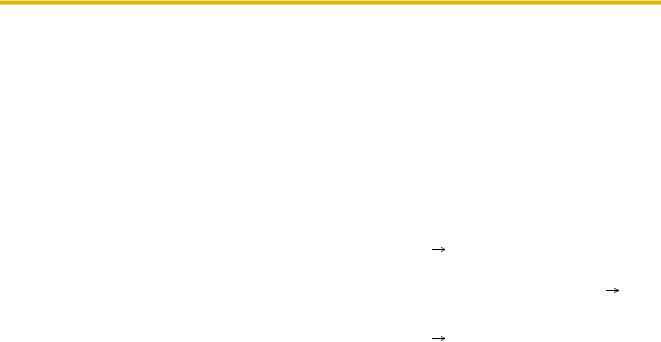
1.1 Incoming Call Features
1.1.1.2Intercept Routing
Description
Redirects incoming outside (CO) line calls via the Direct Inward System Access (DISA) or Uniform Call Distribution (UCD) feature to a preprogrammed destination when the original destination does not, or cannot, answer the call. There are 2 types of Intercept Routing, described below.
Type |
Description |
|
|
|
|
No Dial |
After hearing a dial tone (short beep) or a DISA outgoing message (OGM), if the caller |
|
|
does not dial anything or enters an unrecognised input, the call is redirected to |
|
|
preprogrammed intercept destinations in the following priority: |
|
|
DISA IRNA to BV—Day/Night/Lunch [438-440] |
Flexible Ringing—Day/Night/Lunch |
|
[408-410] |
|
|
|
|
Intercept |
If a called party does not answer a call within a preprogrammed time period ( DISA |
|
Routing—No |
Ring Time before Intercept [508], UCD Ring Time before Intercept [525]), the call is |
|
Answer (IRNA) |
redirected to preprogrammed intercept destinations in the following priority: |
|
|
DISA IRNA to BV—Day/Night/Lunch [438-440] |
Flexible Ringing—Day/Night/Lunch |
|
[408-410] |
|
|
|
|
Feature Guide References
1.2.2 Uniform Call Distribution (UCD)
1.15.6Direct Inward System Access (DISA)
1.15.7Built-in Voice Message (BV)
Feature Guide |
15 |
|
|

1.1 Incoming Call Features
1.1.2Internal Call Features
Description
There are 2 types of internal calls, described below.
Feature |
Description |
Details in |
|
|
|
Intercom Call |
A call from one extension to another. |
• 1.5.1.1 Intercom |
|
|
Call |
|
|
|
Doorphone Call |
A call made from a doorphone to its preprogrammed destination |
• 1.15.1 |
|
for the current time service mode, assigned to the doorphone's |
Doorphone Call |
|
port ( 2.2.3 Time Service). |
|
|
|
|
16 Feature Guide

1.1 Incoming Call Features
1.1.3Incoming Call Indication Features
1.1.3.1Incoming Call Indication Features—OVERVIEW
Description
Extension telephones can indicate an incoming call in various ways, described below.
Indication Type |
Feature |
Description |
Details in |
|
|
|
|
Ring/No Ring |
Outside (CO) Line |
Each extension can be programmed to |
• 1.1.3.2 Outside |
|
Ringing Selection |
ring or not ring when receiving an outside |
(CO) Line Ringing |
|
|
(CO) line call. |
Selection |
|
|
|
|
Ring Tone |
Ring Tone Pattern |
A telephone rings when receiving a call. |
• 1.1.3.3 Ring |
|
Selection |
A different ring tone pattern can be |
Tone Pattern |
|
|
assigned to each incoming call type. |
Selection |
|
|
|
|
Voice-calling |
Alternate |
Proprietary telephone (PT) users can |
• 1.5.1.1 Intercom |
|
Receiving—Ring/ |
choose how their telephones receive |
Call |
|
Voice |
intercom calls, by selecting to hear ring |
|
|
|
tones or the caller's voice. |
|
|
|
|
|
LED (Light Emitting |
LED Indication |
The LED indicators on a PT can indicate |
• 1.18.3 LED |
Diode) |
|
the status of different lines using light |
Indication |
|
|
patterns and colours. |
|
|
|
|
|
Display (Caller |
Display Information |
A user's PT can show a variety of |
• 1.18.4 Display |
Information) |
|
information on the display, such as the |
Information |
|
|
outside (CO) line number, the caller's |
|
|
|
name and number, the extension number |
|
|
|
and name of the calling extension after |
|
|
|
the call is forwarded, etc. |
|
|
|
|
|
Tone During a |
Call Waiting |
When an extension user is in the middle |
• 1.1.3.5 Call |
Conversation |
|
of a call, the user can be alerted to a new |
Waiting |
|
|
call by a call waiting tone. |
|
|
|
|
|
Feature Guide |
17 |
|
|

1.1 Incoming Call Features
1.1.3.2Outside (CO) Line Ringing Selection
Description
An extension user can select whether the telephone will ring or not when receiving call(s) from assigned or all outside (CO) lines through personal programming.
Conditions
•System programming determines which extension(s) will ring for incoming outside (CO) line calls in each time service mode ( Flexible Ringing—Day/Night/Lunch [408-410]).
Flexible Ringing—Day/Night/Lunch [408-410]).
•If an outside (CO) line call reaches a user's extension, but the extension is set to not ring, the CO button will flash. The outside (CO) line call can be answered by pressing the flashing CO button.
User Manual References
3.1.2 Changing Settings Using Programming Mode
18 Feature Guide

1.1 Incoming Call Features
1.1.3.3Ring Tone Pattern Selection
Description
A different ring tone pattern can be assigned to each incoming call type, such as intercom calls ( Extension Ring Tone Pattern [115]), calls from each doorphone (
Extension Ring Tone Pattern [115]), calls from each doorphone ( Doorphone Ring Tone Pattern [706]), and calls from each outside (CO) line (
Doorphone Ring Tone Pattern [706]), and calls from each outside (CO) line ( CO Line Ring Tone Pattern [423]).
CO Line Ring Tone Pattern [423]).
Available ring tone patterns are as follows:
[Ring Tone Patterns]
1 s
Single
Double
Triple
S-Double
(Doorphone only)
Conditions
•The ring tone pattern for incoming calls (intercom calls and outside (CO) line calls) to a single line telephone (SLT) can be fixed to "Single" or "Double" for each extension through system programming ( SLT Fixed Bell Pattern [629]). The length of the ring tone pattern depends on the preprogrammed length of the bell-on signal (
SLT Fixed Bell Pattern [629]). The length of the ring tone pattern depends on the preprogrammed length of the bell-on signal ( SLT Ring Bell-on Time [143]), combined with the ratio between the bell signals of the SLT (
SLT Ring Bell-on Time [143]), combined with the ratio between the bell signals of the SLT ( SLT Ring/Silence Ratio [142]). Depending on the type of SLT being used, the SLT may not ring properly, if the ring tone pattern of the SLT is set differently from that used by the telephone company.
SLT Ring/Silence Ratio [142]). Depending on the type of SLT being used, the SLT may not ring properly, if the ring tone pattern of the SLT is set differently from that used by the telephone company.
Feature Guide References
1.1.3.2 Outside (CO) Line Ringing Selection
4.2.1 Tones/Ring Tones
Feature Guide |
19 |
|
|

1.1 Incoming Call Features
1.1.3.4Distinctive Ring Detection (DRD) for New Zealand
Description
Distinctive Ring Detection (DRD) is only available in New Zealand.
The PBX can detect the following 4 ring tone patterns sent from the telephone company for each outside (CO) line. When the PBX detects one of the ring tone patterns, the call will be transferred to the preprogrammed destination(s) automatically according to system programming. In addition, the extension ring tone pattern for the detected call can be assigned through system programming as shown below.
[Ring Tone Patterns Sent from the Telephone Company]
1 s
Pattern 1
(Normal)
Pattern 2
(Voice)
Pattern 3
(Modem/Voice)
Pattern 4
(Fax)
Pattern |
Destination assigned in |
Ring Tone Pattern assigned in |
|
|
|
1 |
Flexible Ringing—Day/Night/Lunch [408- |
CO Line Ring Tone Pattern [423] |
|
410], or sent to the Direct Inward System |
|
|
Access (DISA) line or Uniform Call |
|
|
Distribution (UCD) group |
|
|
|
|
2 |
DRD Ring Pattern 2 Extension Assignment— |
DRD Pattern 2 and 3 Ring Tone [433-434] |
|
Day/Night/Lunch [427-429] (New Zealand |
(New Zealand only) |
|
only) |
|
|
|
|
3 |
DRD Ring Pattern 3 Extension Assignment— |
DRD Pattern 2 and 3 Ring Tone [433-434] |
|
Day/Night/Lunch [430-432] (New Zealand |
(New Zealand only) |
|
only) |
|
|
|
|
4 |
FAX Connection [503] |
CO Line Ring Tone Pattern [423] |
|
|
|
Conditions
•To use this feature, "UCD", "DISA", or "Normal" must be selected as the distribution method for the desired outside (CO) line port ( CO Line Mode—Day/Night/Lunch [414-416]) and DRD must be enabled (
CO Line Mode—Day/Night/Lunch [414-416]) and DRD must be enabled ( Distinctive Ring Detection (DRD) [426] (New Zealand only)).
Distinctive Ring Detection (DRD) [426] (New Zealand only)).
Feature Guide References
1.2.2 Uniform Call Distribution (UCD)
20 Feature Guide

1.1 Incoming Call Features
1.15.6 Direct Inward System Access (DISA)
4.2.1 Tones/Ring Tones
Feature Guide |
21 |
|
|

1.1 Incoming Call Features
1.1.3.5Call Waiting
Description
A busy extension user can be alerted to a new call by Call Waiting. The busy extension user can then answer the second call either by disconnecting the current call or placing it on hold.
If Call Waiting is enabled, a call waiting tone will be sent to the user under the following conditions:
a)When an outside (CO) line call or a doorphone call is received, or
b)When another extension executes the Busy Station Signalling (BSS) feature. If disabled, a reorder tone will be sent to the extension that executed the BSS feature.
Call Waiting from the Telephone Company
Besides the Call Waiting feature provided by the PBX, you can also subscribe to your telephone company's Call Waiting service and receive call waiting tones through the telephone company's lines. This feature is available when an extension is in a conversation with an outside party, and a call is received from another outside party on the same outside (CO) line. The external call waiting tone will alert an extension user of the incoming outside (CO) line call that is waiting. The user can answer the second call by disconnecting the current call or placing it on hold. If a call waiting tone is heard but the corresponding CO button does not flash, this tone is an external call waiting tone from the telephone company. For details, consult your telephone company.
Conditions
•Data Line Security
When an extension user activates Data Line Security, Call Waiting is turned off ( 1.10.5 Data Line Security).
1.10.5 Data Line Security).
•Call Waiting Tone
A proprietary telephone (PT) user can select the preferred call waiting tone through personal programming (Call Waiting Tone Type Selection).
•Caller ID Information
When an extension receives a call waiting tone, the caller's information will flash on the display for 5 seconds at 15-second intervals.
Feature Guide References
1.7.3 Call Waiting Tone
4.2.1 Tones/Ring Tones
User Manual References
1.2.4 When the Dialled Party is Busy or There is No Answer 1.4.4 Answering Call Waiting
1.7.3 Receiving Call Waiting
3.1.2 Changing Settings Using Programming Mode
22 Feature Guide
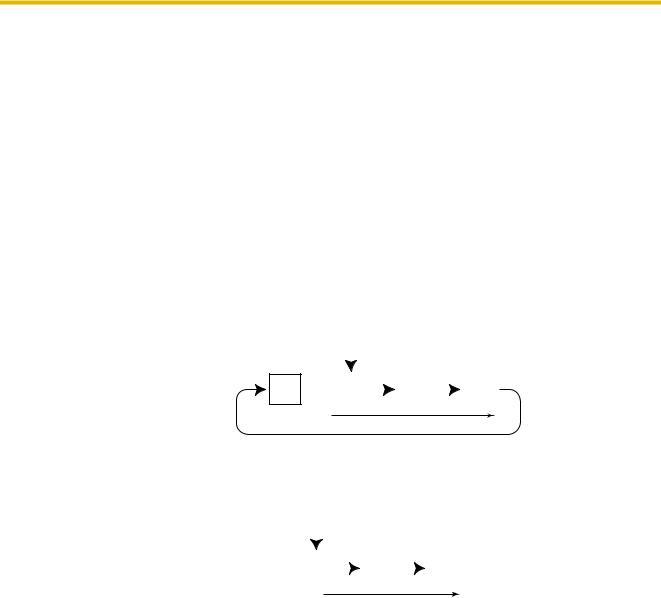
1.2 Receiving Group Features
1.2Receiving Group Features
1.2.1Idle Extension Hunting
Description
If a called extension is busy, Idle Extension Hunting redirects the call to an idle member of the same extension group, if that group has been assigned as an idle extension hunting group through system programming ( Hunting Group Set [100]). Idle extensions are automatically searched for according to a preprogrammed hunting type (
Hunting Group Set [100]). Idle extensions are automatically searched for according to a preprogrammed hunting type ( Hunting Type [101]).
Hunting Type [101]).
This feature is also known as Station Hunting.
Type |
|
|
|
|
|
|
|
|
|
|
|
|
Description |
||||||||
|
|
|
|
|
|
|
|
|
|
|
|
|
|
|
|
|
|
|
|
|
|
Circular Hunting |
An idle extension is searched for in a circular fashion one time according |
||||||||||||||||||||
|
to the numerical order of the jacks. |
|
|
||||||||||||||||||
|
|
|
|
|
Incoming call |
|
|
|
|
|
|
|
|
|
|||||||
|
|
|
|
|
|
|
|
|
|
|
|
|
|
|
|
|
|
|
|
|
|
|
|
|
|
|
|
|
|
|
|
|
|
|
|
|
|
|
|
|
|
|
|
|
|
|
|
|
|
|
|
|
|
|
|
|
|
|
|
|
|
|
|
|
|
|
|
|
Extn. |
Busy |
|
|
|
|
Busy |
|
|
|
|
|
Busy |
|
|||||
|
|
|
Extn. |
|
|
|
|
Extn. |
|
|
|
|
|
Extn. |
|
||||||
|
|
|
|
|
|
|
|
|
|
|
|
|
|
|
|
|
|||||
|
|
Numerical order |
|
|
|
|
|
|
|
|
|
|
|
|
|
|
|
||||
|
|
|
|
|
|
|
|
|
|
|
|
|
|
|
|
|
|||||
|
|
|
|
|
|
|
|
|
|
|
|
|
|
|
|
|
|
|
|
|
|
Terminated Hunting |
An idle extension is searched for in the numerical order of the jacks, until |
||||||||||||||||||||
|
reaching the extension that is connected to the highest-numbered jack in |
||||||||||||||||||||
|
the group. |
|
|
|
|
|
|
|
|
|
|
|
|
|
|
|
|||||
|
|
|
Incoming call |
|
|
|
|
|
Highest- |
|
|
||||||||||
|
|
|
|
|
|
|
|
|
|
|
|
|
|
|
|
||||||
|
|
|
|
|
|
|
|
|
|
|
|
|
|
|
|||||||
|
|
|
|
|
|
|
|
|
|
|
|
|
|
numbered jack |
|||||||
|
|
|
|
|
|
|
|
|
|
|
|
|
|||||||||
|
|
|
|
|
|
|
|
|
|
|
|
|
|
|
|
|
|||||
|
|
Extn. |
|
Busy |
|
|
|
Busy |
|
|
|
Busy |
|
|
|
||||||
|
|
|
Extn. |
|
|
|
Extn. |
|
|
|
Extn. |
|
|
|
|
||||||
|
|
|
|
|
|
|
|
|
|
|
|
|
|||||||||
|
|
|
|
|
|
|
|
|
|
|
|
|
|
|
|
|
|
|
|
|
|
|
|
Numerical order |
|
|
|
|
|
|
|
|
|
|
|
|
|
|
|
||||
|
|
|
|
|
|
|
|
|
|
|
|
|
|
|
|
|
|
|
|
|
|
Conditions
•Idle Extension Hunting applies to:
Intercom calls and outside (CO) line calls directed to a single extension.
•An extension can belong to only one extension group ( Extension Group [600]). One hunting type can be programmed for each extension group.
Extension Group [600]). One hunting type can be programmed for each extension group.
•If all the searched extensions are busy, a busy tone will be heard.
•A user can leave an idle extension hunting group temporarily by logging out of the group, and rejoin the group by logging back in ( 1.2.4 Log-in/Log-out).
1.2.4 Log-in/Log-out).
•FWD/DND Mode
When searching for an idle extension within an idle extension hunting group, any extension that has set FWD, DND, or Log-out will be skipped ( 1.3.1 Call Forwarding (FWD)/Do Not Disturb (DND)). However, if the extension that receives the call first has set FWD or DND, Idle Extension Hunting will not function and the call will be forwarded to the preprogrammed destination (when FWD is set) or will not be received at all (when DND is set).
1.3.1 Call Forwarding (FWD)/Do Not Disturb (DND)). However, if the extension that receives the call first has set FWD or DND, Idle Extension Hunting will not function and the call will be forwarded to the preprogrammed destination (when FWD is set) or will not be received at all (when DND is set).
Feature Guide |
23 |
|
|

1.2 Receiving Group Features
•Message Waiting
A message waiting indication will not be sent to an idle extension hunting destination.
The MESSAGE button light or Message/Ringer Lamp turns on at the original destination only ( 1.17.1 Message Waiting).
1.17.1 Message Waiting).
Feature Guide References
2.2.2 Group
24 Feature Guide
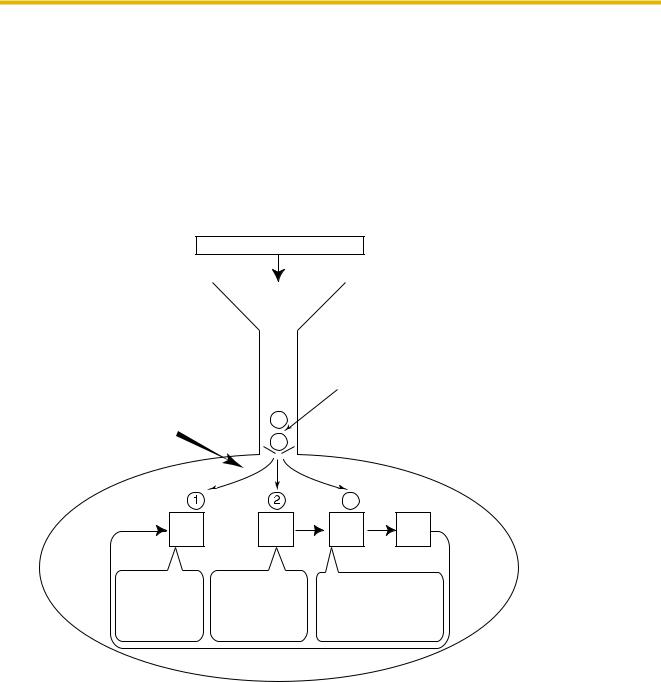
1.2 Receiving Group Features
1.2.2Uniform Call Distribution (UCD)
Description
Uniform Call Distribution (UCD) distributes incoming calls to an idle member of the same extension group, if that group has been assigned as a UCD group through system programming ( UCD Group [520]). Available extensions are searched for in a circular fashion in numerical order. The UCD feature is particularly helpful when a certain extension typically receives more calls than other extensions.
UCD Group [520]). Available extensions are searched for in a circular fashion in numerical order. The UCD feature is particularly helpful when a certain extension typically receives more calls than other extensions.
[Example of UCD Group]
The numbers found in circles below indicate calls and the order in which they arrived.
Calls arrive at the UCD group.
Call Distribution
Calls are distributed in the numerical order of the jacks.
Extn.
A
Extn. A receives the first call.
Extn.
B
UCD starts searching from extn. B (Skips extn. A).
Queuing
When the destination extension is busy or is logged out, the call waits in the queue and a UCD OGM is sent to the caller.
3 |
|
Extn. |
Extn. |
C |
D |
When the second call arrives at extn. B, the third call will be directed to extn. C.
Feature Guide |
25 |
|
|
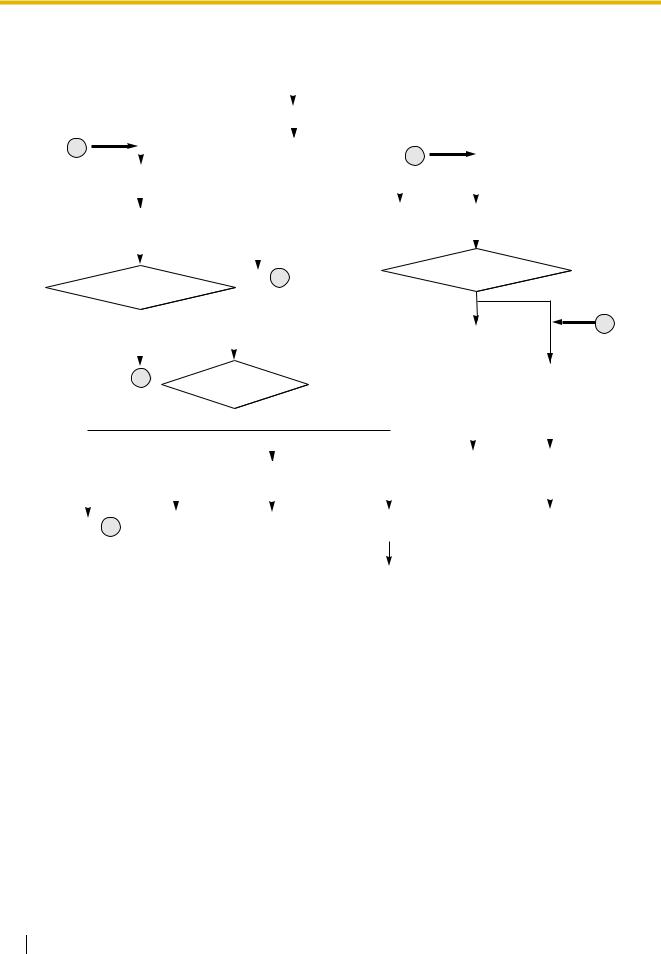
1.2 Receiving Group Features
[Flowchart]
|
|
|
|
|
|
|
|
|
|
|
A UCD call from an outside |
|
|
|
|
|
|
|
|
|
|
|
|
|
|
|
|
||||||||
|
|
|
|
|
|
|
|
|
|
|
|
|
party is received. |
|
|
|
|
|
|
|
|
|
|
|
|
|
|
|
|
|
|
||||
|
|
|
|
|
|
|
|
|
|
|
|
|
|
|
|
|
|
|
|
|
|
|
|
|
|
|
|
|
|
|
|
|
|
|
|
|
|
|
|
|
|
|
|
|
|
|
|
|
|
|
|
|
|
|
|
|
|
|
|
|
|
|
|
|
|
|
|
|
|
|
|
|
|
|
|
|
|
|
|
|
|
|
|
|
|
|
|
|
|
|
|
|
|
|
|
|
|
|
|
|
|
|
|
|
|
|
|
|
|
|
|
|
|
|
|
|
|
The call reaches the UCD group. |
|
|
|
|
|
|
|
|
|
|
|
|
|
|
|
|
|||||||||
|
|
|
|
|
|
Busy |
|
|
|
|
|
|
|
|
|
|
|
|
Rings (when an extension is available) |
||||||||||||||||
|
|
|
|
|
|
|
|
|
|
|
|
|
|
|
|
||||||||||||||||||||
|
|
|
|
|
|
|
|
|
|
|
|
|
|
|
|
|
|
|
|
|
|
|
|
|
|
|
|
|
|
|
|
|
|
|
|
|
A |
|
|
|
|
|
|
|
|
|
|
|
|
|
|
|
|
|
B |
|
|
|
|
|
|
|
|
|
|
|
|||||
|
|
|
|
|
|
|
|
|
|
|
|
|
|
|
|
|
|
|
|
|
|
|
|
|
|
|
|
|
|
|
|
|
|||
|
|
|
|
|
|
|
|
|
|
|
|
|
|
|
|
|
|
|
|
|
|
|
|
|
|
|
|
|
|
|
|
|
|
||
|
|
|
UCD OGM |
|
|
|
|
|
|
|
|
|
|
|
|
|
|
|
|
|
|
|
|
|
(UCD Ring Time before |
||||||||||
|
|
|
|
|
|
|
|
|
|
|
|
|
|
|
|
|
|
|
|
|
|
|
|
|
|
|
|
||||||||
|
|
|
|
|
|
|
|
|
|
|
|
|
|
|
|
|
|
|
|
|
|
|
|
|
|
|
|
Intercept expires) |
|||||||
|
|
|
|
|
|
|
|
|
|
|
|
|
|
|
|
|
|
|
|
|
|
|
|
|
|
|
|
||||||||
|
|
|
|
|
|
|
|
|
|
|
|
|
|
|
|
|
|
|
|
|
|
|
|
|
|
|
|
|
|
|
|
||||
|
Music on Hold is sent to the caller. |
|
|
|
|
|
|
|
|
The call is |
|
|
The call is not |
|
|
|
|
|
|||||||||||||||||
|
|
|
|
|
|
|
|
|
|
|
|
|
Rings (when an |
|
established. |
|
|
|
answered. |
|
|
|
|
|
|||||||||||
|
|
|
|
|
|
|
|
|
|
|
|
|
|
|
|
|
|
||||||||||||||||||
|
|
Busy |
|
|
|
|
|
|
|
|
extension is available) |
|
|
|
|
|
|
|
|
|
|
|
|
|
|
|
|||||||||
|
|
|
|
|
|
|
|
|
|
Is Intercept Routing |
|||||||||||||||||||||||||
|
|
|
|
|
|
|
|
|
|
|
|
|
|
|
|
|
|
|
|
||||||||||||||||
|
|
|
|
|
|
|
|
|
|
|
Goes to B |
|
|
|
|
|
|||||||||||||||||||
|
|
|
|
|
|
|
|
|
|
|
|
|
|||||||||||||||||||||||
|
|
Did the UCD Busy |
|
|
|
|
|
|
|
|
|
employed? |
Yes |
||||||||||||||||||||||
|
|
Waiting Time expire? |
|
|
|
|
|
|
|
|
|
|
|
|
|
|
|
|
|
|
|
|
|
||||||||||||
|
|
|
|
|
|
|
|
|
|
|
|
|
|
|
|
|
|
|
|
|
|
|
|
|
|
|
|
||||||||
|
|
|
No |
|
|
|
|
|
|
|
|
Yes |
|
|
|
|
|
|
|
|
No |
|
|
|
C |
||||||||||
|
|
|
|
|
|
|
|
|
|
|
|
|
|
|
|
|
|
|
|
|
|
|
|
|
|
|
|||||||||
|
|
|
|
|
|
|
|
|
|
|
|
|
|
|
|
|
|
|
|
|
|
|
|
|
The call is |
|
|
|
|
|
|||||
|
|
|
|
|
|
|
|
|
|
|
|
|
|
|
|
|
|
|
|
|
|
|
|
|
disconnected. |
|
|
|
|
|
|||||
|
|
|
|
|
|
|
|
|
|
|
|
|
|
|
|
|
|
|
|
|
|
|
|
|
|
|
|
|
|
||||||
|
|
|
|
|
|
|
|
|
|
|
|
|
|
|
|
|
|
|
|
|
|
|
|
|
|
|
|
|
|
|
|
|
|
||
|
|
|
|
|
|
|
|
|
|
|
|
|
|
|
|
|
|
|
|
|
|
|
|
|
|
|
|
|
|
|
|
|
|
|
|
|
|
Goes to A |
|
|
|
What is the |
|
|
|
|
|
|
|
|
|
|
|
The call is directed |
|
||||||||||||||||
|
|
|
|
|
|
|
|
|
|
|
|
|
|
|
|
to another extension. |
|
||||||||||||||||||
|
|
|
|
|
|
|
|
UCD Busy Mode ? |
|
|
|
|
|
|
|
|
|
|
|
|
|||||||||||||||
|
|
|
|
|
|
|
|
|
|
|
|
|
|
|
|
|
|
|
|
|
|
|
|
|
|
||||||||||
Intercept-Normal |
Disconnect |
|
|
Disconnect-OGM |
Intercept-DISA |
|
|
|
|
|
|
|
(UCD Ring Time after |
||||||||||||||||||||||
|
|
|
|
|
|
|
|
|
|||||||||||||||||||||||||||
|
|
|
|
|
|
|
|
|
|||||||||||||||||||||||||||
|
|
|
|
|
|
|
|
|
Intercept expires) |
||||||||||||||||||||||||||
|
|
|
|
|
|
|
|
|
|
|
|
|
|
|
|
|
|
|
|
|
|
|
|
|
|
|
|
|
|
|
|
|
|
|
|
|
|
|
|
|
|
|
|
|
|
|
|
|
|
|
|
|
|
|
|
|
|
|
|
|
|
|
|
|
|
|
|
|
|
|
|
|
|
|
|
|
|
|
|
|
|
|
|
|
|
|
|
|
|
|
|
|
|
|
|
|
|
The call is |
|
The call is not |
|
||||||
|
|
|
|
|
|
|
|
|
|
|
A UCD OGM is sent |
|
|
|
|
|
|
|
|
|
established. |
|
answered. |
|
|||||||||||
|
|
|
|
|
|
|
|
|
|
|
|
to the caller. |
|
|
|
|
|
|
|
|
|
|
|
|
|
|
|
|
|
|
|
||||
|
|
|
|
|
|
|
|
|
|
|
|
|
|
|
|
|
|
|
|
|
|
|
|
|
|
|
|
|
|
|
|||||
|
|
|
|
|
|
|
|
|
|
|
|
|
|
|
|
|
|
|
|
|
|
|
|
|
|
|
|
|
|
|
|
|
|
|
|
|
|
|
|
|
|
|
|
|
|
|
|
|
|
|
|
|
|
|
|
|
|
|
|
|
|
|
|
|
|
|
|
|
|
|
|
|
Goes to C |
|
The call is |
|
|
The call is |
|
A DISA OGM is sent |
|
|
|
|
|
|
|
The call is |
|
|
|||||||||||||||||
|
|
disconnected. |
|
|
disconnected. |
|
|
to the caller. |
|
|
|
|
|
|
|
disconnected. |
|
|
|
||||||||||||||||
|
|
|
|
|
|
|
|
|
|
|
|
|
|
|
|
|
|
||||||||||||||||||
Goes to DISA
UCD Busy Mode
When all extensions in a UCD group are busy, a call will wait for a preprogrammed length of time ( UCD Busy Waiting Time [521]). If this timer expires, the PBX will handle the call in one of the following ways according to system programming (
UCD Busy Waiting Time [521]). If this timer expires, the PBX will handle the call in one of the following ways according to system programming ( UCD Busy Mode [523]):
UCD Busy Mode [523]):
a)Disconnect: The call is disconnected immediately.
b)Disconnect-OGM: The call is disconnected after a UCD outgoing message (OGM) plays (e.g., "We are still handling other calls. Please call back later.").
c)Intercept-Normal: The call is directed to preprogrammed destinations ( Flexible Ringing—Day/ Night/Lunch [408-410]).
Flexible Ringing—Day/ Night/Lunch [408-410]).
d)Intercept-DISA: The call is directed to the DISA feature ( 1.15.6 Direct Inward System Access (DISA)) and the caller hears a DISA OGM (e.g., "Thank you for calling Company A. Press 1 to speak to Sales. Press 2 to speak to Support.").
1.15.6 Direct Inward System Access (DISA)) and the caller hears a DISA OGM (e.g., "Thank you for calling Company A. Press 1 to speak to Sales. Press 2 to speak to Support.").
26 Feature Guide

1.2 Receiving Group Features
UCD Intercept Mode
When extensions in a UCD group are available but do not answer an outside (CO) line call within a preprogrammed length of time ( UCD Ring Time before Intercept [525]), the PBX will handle the call in one of the following ways according to system programming (
UCD Ring Time before Intercept [525]), the PBX will handle the call in one of the following ways according to system programming ( UCD Intercept Mode [524]):
UCD Intercept Mode [524]):
a)Disconnect: The call is disconnected. If a UCD OGM is not played, the call will not be disconnected until the caller goes on-hook.
b)Intercept: The call is directed to preprogrammed destinations ( Flexible Ringing—Day/Night/ Lunch [408-410]). The extensions that receive the redirected call ring for a preprogrammed time period (
Flexible Ringing—Day/Night/ Lunch [408-410]). The extensions that receive the redirected call ring for a preprogrammed time period ( UCD Ring Time after Intercept [526]). When the timer expires, the call is disconnected. If a UCD OGM is not played, the call will not be disconnected until the caller goes on-hook.
UCD Ring Time after Intercept [526]). When the timer expires, the call is disconnected. If a UCD OGM is not played, the call will not be disconnected until the caller goes on-hook.
Conditions
•To use this feature, "UCD" must be selected as the distribution method for the desired outside (CO) line port ( CO Line Mode—Day/Night/Lunch [414-416]).
CO Line Mode—Day/Night/Lunch [414-416]).
•It is possible to select the UCD OGM sent to the caller when a call arrives at a UCD group and all extensions in the group are busy ( UCD Waiting Message [527]).
UCD Waiting Message [527]).
•The Log-in or Log-out status can be set for each extension ( 1.2.4 Log-in/Log-out). The last member of a group cannot log out.
1.2.4 Log-in/Log-out). The last member of a group cannot log out.
•FWD/DND Mode
When searching for an available extension, any extension that has set FWD—All Calls, FWD—Busy/ No Answer, or DND will be skipped ( 1.3.1 Call Forwarding (FWD)/Do Not Disturb (DND)).
1.3.1 Call Forwarding (FWD)/Do Not Disturb (DND)).
•UCD Busy Waiting Time
It is possible to assign the length of time ( UCD Busy Waiting Time [521]) the PBX holds an incoming outside (CO) line call via the UCD feature when all extensions in the UCD group are busy, and to assign the interval time between the repeated UCD OGMs (
UCD Busy Waiting Time [521]) the PBX holds an incoming outside (CO) line call via the UCD feature when all extensions in the UCD group are busy, and to assign the interval time between the repeated UCD OGMs ( UCD OGM Message Interval Time [522]).
UCD OGM Message Interval Time [522]).
•Cyclic Tone Detection
It is possible to select the number of times a cyclic tone must be detected while the UCD OGM is sent ( Cyclic Tone Detection [513]). Cyclic Tone Detection can be used to disconnect an outside (CO) line call via UCD.
Cyclic Tone Detection [513]). Cyclic Tone Detection can be used to disconnect an outside (CO) line call via UCD.
Feature Guide References
1.1.1.2 Intercept Routing
1.12.4 Music on Hold
2.2.2 Group
Feature Guide |
27 |
|
|

1.2 Receiving Group Features
1.2.3Direct Inward System Access (DISA) Ring
Description
A Direct Inward System Access (DISA) ring group is a specific extension group that receives DISA calls directed to the group. All extensions in the DISA ring group assigned as an Automated Attendant (AA) destination ( DISA Built-in AA [501]) ring simultaneously.
DISA Built-in AA [501]) ring simultaneously.
Delayed Ringing
Each extension can be programmed for Delayed Ringing ( Delayed Ringing—Day/Night/Lunch [411413]), which allows extensions to be alerted to calls by flashing buttons only. Received calls can be answered even if they are not ringing.
Delayed Ringing—Day/Night/Lunch [411413]), which allows extensions to be alerted to calls by flashing buttons only. Received calls can be answered even if they are not ringing.
Extn. |
|
Extn. |
|
Extn. |
|
Extn. |
A |
|
B |
|
C |
|
D |
Immediately ring simultaneously. |
Delayed Ringing: |
|
Rings after a |
|
specified time delay. |
Conditions
•To use this feature, "DISA" must be selected as the distribution method for the desired outside (CO) line port ( CO Line Mode—Day/Night/Lunch [414-416]), and DISA AA service must be assigned as the destination of incoming outside (CO) line calls via the DISA feature (
CO Line Mode—Day/Night/Lunch [414-416]), and DISA AA service must be assigned as the destination of incoming outside (CO) line calls via the DISA feature ( DISA Incoming Call Dial Mode [500]).
DISA Incoming Call Dial Mode [500]).
•The Log-in or Log-out status can be set for each extension ( 1.2.4 Log-in/Log-out). The last member of a group cannot log out.
1.2.4 Log-in/Log-out). The last member of a group cannot log out.
Feature Guide References
1.15.6 Direct Inward System Access (DISA)
2.2.2 Group
28 Feature Guide

1.2 Receiving Group Features
1.2.4Log-in/Log-out
Description
Members of an idle extension hunting group, Direct Inward System Access (DISA) ring group, or Uniform Call Distribution (UCD) group can join (Log-in) or leave (Log-out) groups manually. Group members can log in at the beginning of a work shift when they are ready to answer calls, and log out at the end of the work shift.
Conditions
•The last member of a group cannot log out.
•While logged out from a group, a member extension will not receive calls to that group via the DISA, UCD, or Idle Extension Hunting features.
•Log-in/Log-out Button
A flexible CO button can be customised as a Log-in/Log-out button. It shows the current status as follows:
Light Pattern |
Status |
|
|
Red on |
Logged out |
|
|
Off |
Logged in |
|
|
Feature Guide References
1.2.1Idle Extension Hunting
1.2.2Uniform Call Distribution (UCD)
1.2.3Direct Inward System Access (DISA) Ring
1.18.2Flexible Buttons
User Manual References
1.5.4 Leaving a Group (Log-in/Log-out)
Feature Guide |
29 |
|
|

1.3 Call Forwarding (FWD)/Do Not Disturb (DND) Features
1.3Call Forwarding (FWD)/Do Not Disturb (DND) Features
1.3.1Call Forwarding (FWD)/Do Not Disturb (DND)
1.3.1.1Call Forwarding (FWD)/Do Not Disturb (DND)—OVERVIEW
Description
When an extension user cannot answer calls (is on a call, out of the office, etc.), it is possible to forward or refuse calls directed to that extension using the following features:
1.Call Forwarding (FWD)
2.Do Not Disturb (DND)
1.FWD
Extension users can forward their incoming calls to preset destinations ( 1.3.1.2 Call Forwarding (FWD)).
1.3.1.2 Call Forwarding (FWD)).
2.DND
An extension user can send a DND tone to let the caller know that he or she is not available ( 1.3.1.3 Do Not Disturb (DND)).
1.3.1.3 Do Not Disturb (DND)).
Conditions
•FWD/DND Button
If a proprietary telephone (PT) does not have an FWD/DND button, a flexible CO button can be customised as an FWD/DND button.
[Button Status]
The FWD/DND button shows the current status as follows:
Light Pattern |
Status |
|
|
Red on |
DND on |
|
|
Slow red flashing |
FWD on |
|
|
Off |
FWD/DND off |
|
|
•Setting a new FWD mode, such as All Calls or Busy/No Answer, or the DND feature, clears the status of the previous FWD mode or DND feature.
Feature Guide References
1.18.1Fixed Buttons
1.18.2Flexible Buttons
30 Feature Guide
